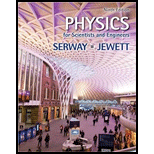
Concept explainers
(a)
The light intensity at the surface of the light bulb.
(a)
Answer to Problem 36.83AP
The light intensity at the surface of the light bulb is
Explanation of Solution
Given info:
The diameter of the spherical light bulb is
Formula to calculate the intensity at the surface of the light bulb is,
Here,
Substitute
Conclusion:
Therefore, the light intensity at the surface of the light bulb is
(b)
The light intensity at a distance
(b)
Answer to Problem 36.83AP
The light intensity at a distance
Explanation of Solution
Given info: The diameter of the spherical light bulb is
Formula to calculate the intensity at a distance
,
Here,
Substitute
Conclusion:
Therefore, the light intensity at a distance
(c)
The diameter of the light bulb image.
(c)
Answer to Problem 36.83AP
The diameter of the light bulb image is
Explanation of Solution
Given info: The diameter of the spherical light bulb is
From the lens maker formula,
Here,
Substitute
Thus, the image distance is
Formula to calculate the magnification of the image,
Here,
Formula to calculate the magnification of the image in terms of image and object distance is,
Here,
Equate the equation (1) and (2) and then rearrange for
Substitute
Conclusion:
Therefore, the diameter of the light bulb image is
(d)
The light intensity of the image.
(d)
Answer to Problem 36.83AP
The light intensity of the image is
Explanation of Solution
Given info: The diameter of the spherical light bulb is
From part (b) the light intensity at a distance
From part (c) the diameter of the light bulb image is
Formula to calculate the power of lens is,
Here,
The area of the lens is,
Substitute
The area of the lens is
Substitute
Formula to calculate the required intensity of bulb light image,
The area of image is,
Substitute
Substitute
Conclusion:
Therefore, the light intensity of the image is
Want to see more full solutions like this?
Chapter 36 Solutions
PHYSICS 1250 PACKAGE >CI<
- Can someone help me with this question. Thanks.arrow_forwardIdentical rays of light enter three transparent blocks composed of different materials. Light slows down upon entering the blocks.arrow_forwardFor single-slit diffraction, calculate the first three values of (the total phase difference between rays from each edge of the slit) that produce subsidiary maxima by a) using the phasor model, b) setting dr = 0, where I is given by, I = Io (sin (10) ². 2arrow_forward
 Physics for Scientists and Engineers, Technology ...PhysicsISBN:9781305116399Author:Raymond A. Serway, John W. JewettPublisher:Cengage Learning
Physics for Scientists and Engineers, Technology ...PhysicsISBN:9781305116399Author:Raymond A. Serway, John W. JewettPublisher:Cengage Learning Principles of Physics: A Calculus-Based TextPhysicsISBN:9781133104261Author:Raymond A. Serway, John W. JewettPublisher:Cengage Learning
Principles of Physics: A Calculus-Based TextPhysicsISBN:9781133104261Author:Raymond A. Serway, John W. JewettPublisher:Cengage Learning Physics for Scientists and Engineers: Foundations...PhysicsISBN:9781133939146Author:Katz, Debora M.Publisher:Cengage Learning
Physics for Scientists and Engineers: Foundations...PhysicsISBN:9781133939146Author:Katz, Debora M.Publisher:Cengage Learning Glencoe Physics: Principles and Problems, Student...PhysicsISBN:9780078807213Author:Paul W. ZitzewitzPublisher:Glencoe/McGraw-Hill
Glencoe Physics: Principles and Problems, Student...PhysicsISBN:9780078807213Author:Paul W. ZitzewitzPublisher:Glencoe/McGraw-Hill College PhysicsPhysicsISBN:9781285737027Author:Raymond A. Serway, Chris VuillePublisher:Cengage Learning
College PhysicsPhysicsISBN:9781285737027Author:Raymond A. Serway, Chris VuillePublisher:Cengage Learning University Physics Volume 3PhysicsISBN:9781938168185Author:William Moebs, Jeff SannyPublisher:OpenStax
University Physics Volume 3PhysicsISBN:9781938168185Author:William Moebs, Jeff SannyPublisher:OpenStax





